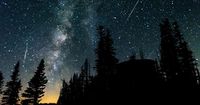For skywatchers across the United Kingdom and beyond, the summer of 2025 is shaping up to be a season to remember. A trio of rare and dramatic celestial phenomena—the Perseid meteor shower, a so-called Black Moon, and a spectacular Blood Moon—are set to put on a show, offering both scientific fascination and spiritual resonance for those who look up.
First on the cosmic calendar is the Perseid meteor shower, one of the most anticipated annual events for stargazers. According to reporting by Go Stargazing and Royal Museums Greenwich, this year’s Perseids are active from July 17 to August 24, 2025, with the last few days in August representing the final opportunity to catch the dazzling display. The shower, renowned for its high hourly rate and brilliant meteors, is a favorite among both amateur astronomers and casual observers.
“As comets get close to the Sun, they heat up and pieces break off. If the debris ends up in the Earth’s path around the Sun, it can slam into our atmosphere at speeds of between 7–45 miles per second. The actual speed at which a meteor enters our atmosphere depends on the combined speed of the Earth and the debris itself. The average speed for a Perseid meteor is 36 miles per second. The air in front of the meteor is squashed and heated to thousands of degrees Celsius. The smaller meteors vaporise and leave behind a bright trail of light. Larger meteors can explode as fireballs,” explained a spokesperson for Royal Museums Greenwich.
For those eager to get the best views, experts recommend escaping city lights and heading for rural areas. The Cotswolds, Herefordshire, Mill Pond near Birts Street, Castlemorton, Long Compton near Chipping Norton, the Shropshire Hills Area of Outstanding Natural Beauty (AONB), Clent Hills, and Barr Beacon (the West Midlands’ only Dark Sky Discovery Site) are all prime locations. The Shropshire Hills, in particular, are celebrated for their dark skies and accessibility.
But this year, the Perseids are getting an extra boost from an unusual astronomical event: the Black Moon. As reported by BBC and Space.com, the Black Moon will occur at 06:06 UTC (07:06 BST) on August 23, 2025. While the name might conjure images of a shadowy orb, the reality is more subtle. The Black Moon isn’t an official astronomical term, but it’s gained popularity to describe either the second new moon in a calendar month or, as in this case, the third of four new moons in a single season—a rare occurrence known as a “seasonal Black Moon.”
This August’s Black Moon is the third new moon of summer 2025 in the northern hemisphere, with new moons having already occurred on June 25 and July 24, and another slated for September 21. The rarity of four new moons in one season makes this event noteworthy. However, unlike a full moon or a lunar eclipse, the Black Moon is not visible. During this phase, the Moon is positioned between the Earth and the Sun, with its illuminated side facing away from us. It rises and sets with the Sun, leaving the night sky unusually dark.
That darkness, as Chron and EarthSky note, is a boon for meteor watchers. With no moonlight to wash out faint meteors, the peak of the Perseid shower around August 24 will be even more striking—weather permitting, of course. Stargazers in Britain and elsewhere are encouraged to take advantage of these especially dark nights to spot the fleeting streaks of light from the meteors.
Beyond its astronomical interest, the Black Moon also holds deep spiritual significance in various traditions. According to the Pagan Grimoire, the new moon’s darkness is seen as a powerful time for rituals centered on cleansing, transformation, and renewal. In Wicca and Paganism, the Black Moon is considered an auspicious moment for reflection and setting new intentions. Astrologers point out that this year’s Black Moon falls under Virgo, a sign associated with purification and the planting of new goals. Some traditions also honor the goddess Hekate at this time, performing the Deipnon ceremony—a ritual of offerings and purification at crossroads before the new lunar cycle begins.
Yet the celestial wonders don’t stop there. Just weeks after the Black Moon, Scotland is set to witness a dramatic total lunar eclipse—popularly known as a Blood Moon—on the evening of Thursday, September 7, 2025. As reported by BBC and Royal Museums Greenwich, this will be the second lunar eclipse visible in the UK in 2025, following the Perseid meteor shower’s grand finale.
The Blood Moon occurs when the Earth moves directly between the Sun and the Moon, casting its shadow over the lunar surface. During a total lunar eclipse, the Moon often takes on a striking orange or red hue, hence the evocative nickname. The maximum eclipse will occur at 7:33 pm BST, with the actual maximum at 7:11 pm when the Moon is still below the horizon in the UK. The Moon will gradually emerge from Earth’s shadow until 9:55 pm, offering a prolonged spectacle for those who manage to catch it.
For the best view, experts recommend finding a high vantage point with a clear view to the east. As always, local weather conditions will play a decisive role—cloud cover could spoil the show, so a bit of luck is required. This advice is echoed by Royal Museums Greenwich, which notes that the Moon will rise above the horizon just in time for the total eclipse, making timing and location crucial for optimal viewing.
The Blood Moon’s appearance, following so closely after both the Perseid meteor shower and the Black Moon, is a rare alignment of astronomical events. For scientists, it’s a reminder of the intricate and predictable rhythms of our solar system. For many others, it’s a source of wonder and inspiration, a chance to reflect on our place in the universe and the stories we tell about the sky.
As summer draws to a close, Britain’s night sky is set to deliver a series of unforgettable moments—moments that bridge science, tradition, and the simple joy of gazing upward. Whether you’re a seasoned astronomer, a spiritual seeker, or just someone looking for a reason to step outside after dark, the summer of 2025 offers a front-row seat to the majesty of the cosmos.

